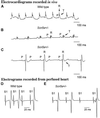Slowed conduction and ventricular tachycardia after targeted disruption of the cardiac sodium channel gene Scn5a
- PMID: 11972032
- PMCID: PMC122928
- DOI: 10.1073/pnas.082121299
Slowed conduction and ventricular tachycardia after targeted disruption of the cardiac sodium channel gene Scn5a
Abstract
Voltage-gated sodium channels drive the initial depolarization phase of the cardiac action potential and therefore critically determine conduction of excitation through the heart. In patients, deletions or loss-of-function mutations of the cardiac sodium channel gene, SCN5A, have been associated with a wide range of arrhythmias including bradycardia (heart rate slowing), atrioventricular conduction delay, and ventricular fibrillation. The pathophysiological basis of these clinical conditions is unresolved. Here we show that disruption of the mouse cardiac sodium channel gene, Scn5a, causes intrauterine lethality in homozygotes with severe defects in ventricular morphogenesis whereas heterozygotes show normal survival. Whole-cell patch clamp analyses of isolated ventricular myocytes from adult Scn5a(+/-) mice demonstrate a approximately 50% reduction in sodium conductance. Scn5a(+/-) hearts have several defects including impaired atrioventricular conduction, delayed intramyocardial conduction, increased ventricular refractoriness, and ventricular tachycardia with characteristics of reentrant excitation. These findings reconcile reduced activity of the cardiac sodium channel leading to slowed conduction with several apparently diverse clinical phenotypes, providing a model for the detailed analysis of the pathophysiology of arrhythmias.
Figures




Comment in
-
Unraveling the genetics and mechanisms of cardiac arrhythmia.Proc Natl Acad Sci U S A. 2002 Apr 30;99(9):5755-6. doi: 10.1073/pnas.102171699. Proc Natl Acad Sci U S A. 2002. PMID: 11983875 Free PMC article. Review. No abstract available.
Similar articles
-
Variable Na(v)1.5 protein expression from the wild-type allele correlates with the penetrance of cardiac conduction disease in the Scn5a(+/-) mouse model.PLoS One. 2010 Feb 19;5(2):e9298. doi: 10.1371/journal.pone.0009298. PLoS One. 2010. PMID: 20174578 Free PMC article.
-
Mapping of reentrant spontaneous polymorphic ventricular tachycardia in a Scn5a+/- mouse model.Am J Physiol Heart Circ Physiol. 2011 May;300(5):H1853-62. doi: 10.1152/ajpheart.00034.2011. Epub 2011 Mar 4. Am J Physiol Heart Circ Physiol. 2011. PMID: 21378142 Free PMC article.
-
p.N1380del mutation in the pore-forming region of SCN5A gene is associated with cardiac conduction disturbance and ventricular tachycardia.Acta Biochim Biophys Sin (Shanghai). 2017 Mar 1;49(3):270-276. doi: 10.1093/abbs/gmx003. Acta Biochim Biophys Sin (Shanghai). 2017. PMID: 28159958
-
A heterozygous deletion mutation in the cardiac sodium channel gene SCN5A with loss- and gain-of-function characteristics manifests as isolated conduction disease, without signs of Brugada or long QT syndrome.PLoS One. 2013 Jun 28;8(6):e67963. doi: 10.1371/journal.pone.0067963. Print 2013. PLoS One. 2013. PMID: 23840796 Free PMC article.
-
Inherited and acquired vulnerability to ventricular arrhythmias: cardiac Na+ and K+ channels.Physiol Rev. 2005 Jan;85(1):33-47. doi: 10.1152/physrev.00005.2004. Physiol Rev. 2005. PMID: 15618477 Review.
Cited by
-
Defective interactions of protein partner with ion channels and transporters as alternative mechanisms of membrane channelopathies.Biochim Biophys Acta. 2014 Feb;1838(2):723-30. doi: 10.1016/j.bbamem.2013.05.024. Epub 2013 May 31. Biochim Biophys Acta. 2014. PMID: 23732236 Free PMC article. Review.
-
Systems biology and cardiac arrhythmias.Lancet. 2012 Oct 27;380(9852):1498-508. doi: 10.1016/S0140-6736(12)61462-7. Lancet. 2012. PMID: 23101717 Free PMC article.
-
Sodium channel traffic on the cardiac microtubule highway.Cardiovasc Res. 2010 Mar 1;85(4):645-6. doi: 10.1093/cvr/cvp404. Epub 2009 Dec 23. Cardiovasc Res. 2010. PMID: 20032082 Free PMC article. No abstract available.
-
Atrial arrhythmogenicity in aged Scn5a+/DeltaKPQ mice modeling long QT type 3 syndrome and its relationship to Na+ channel expression and cardiac conduction.Pflugers Arch. 2010 Aug;460(3):593-601. doi: 10.1007/s00424-010-0851-z. Epub 2010 Jun 16. Pflugers Arch. 2010. PMID: 20552221 Free PMC article.
-
A common genetic variant within SCN10A modulates cardiac SCN5A expression.J Clin Invest. 2014 Apr;124(4):1844-52. doi: 10.1172/JCI73140. Epub 2014 Mar 18. J Clin Invest. 2014. PMID: 24642470 Free PMC article.
References
-
- Spooner P M, Rosen M R, editors. Foundations of Cardiac Arrhythmias: Basic and Clinical Approaches. New York: Dekker; 2001.
-
- The Sicilian Gambit. Cardiovasc Res. 2001;52:345–360. - PubMed
-
- Keating M T, Sanguinetti M C. Cell. 2001;104:569–580. - PubMed
-
- Marban E. Nature (London) 2002;415:213–218. - PubMed
-
- Roden D M, Balser J R, George A L, Jr, Anderson M E. Annu Rev Physiol. 2002;64:431–475. - PubMed
Publication types
MeSH terms
Substances
LinkOut - more resources
Full Text Sources
Other Literature Sources
Molecular Biology Databases
Miscellaneous

